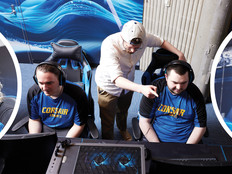Technology Puts College Athletics on a Whole New Playing Field
College sports is big business, so it’s not surprising that institutions are investing in technologies that give players an advantage. On the field, on the sidelines and in on-campus centers, athletics teams are finding that technology is changing the game — literally.
One of the most interesting aspects of this change is that it involves such a wide variety of solutions. We see teams embracing virtual reality, data analytics, mobile devices and upgraded wireless infrastructure. It’s not uncommon for collegiate athletics staff to include a technology component in every phase of their programs: recruiting, training and games, and stadium services for fans.
SIGN UP: Get more news from the EdTech newsletter in your inbox every two weeks!
iPads Turn into Portable Playbooks
One of the neatest projects I’ve read about is at Duke University, which replaced traditional playbooks with iPads for players, coaches and staff. Instead of bringing heavy binders and piles of DVDs to meetings, coaches and players now have access to all that information in a lightweight, portable device. And because it’s easy to add new content, such as recent player videos, the team always has access to the most current information. In addition to saving money and time, coaches say the iPads make it more likely that players will review important information because it’s in a user-friendly format.
The shift to iPads wasn’t a stand-alone improvement, however. The team’s director of technology also chose VMware’s AirWatch, a mobile device management solution, to manage and secure devices remotely. If an iPad is lost or stolen, for example, the director can remotely wipe the contents to ensure that confidential information stays safe.
At Indiana University’s Mark Cuban Center for Sports Media and Technology, aspiring athletes can see what it’s like to play Hoosiers basketball — virtually. An IU student, inspired by her computer graphics class, partnered with center staff to recreate IU’s 17,222-seat stadium in virtual reality. Participants can wear an HTC Vive headset and use controllers to shoot free throws, walk around the court and even try a half-court shot.
3D Printing Innovations Keep Players Safe
The University of Alabama created its Integrative Center for Athletic and Sport Technology (I-CAST) with the goal of optimizing technology to reduce injury and enhance performance. In one project, experts from UA’s College of Engineering used a 3D printer to create a carbon-fiber brace for an injured player. The player, a running back, had broken his arm during the second half of the 2015 season, potentially sidelining him for the Southeastern Conference Championship Game. But a fast recovery, combined with the custom-made protective brace, made it possible for him to play in the championship game.
Other I-CAST innovations have included a special case that keeps Apple iPads from overheating on the field during hot practice days and a mobile device app that pairs with a heart rate monitor to help athletes individualize their training programs.
Stadium Wi-Fi Creates a Better Fan Experience
While many institutions are leveraging technology on behalf of athletes, other colleges are investing in the fan experience. The University of Nebraska, for example, made major upgrades to its historic Memorial Stadium in order to deliver high-quality, reliable connectivity to fans. That wasn’t an easy feat, considering that the stadium seats more than 85,000, routinely sells out and is one of the oldest stadiums in the country, which imposed special design considerations on the placement of wireless access points.
For its solution, the university chose Cisco Connected Stadium Wi-Fi and Cisco StadiumVision, which distributes high-definition video and digital content to TVs and digital signage throughout the facility, along with 800 wireless APs. A new app, which lets fans access HD content from their smartphones, is supported by Cisco StadiumVision Mobile. Together, these systems provide a seamless Wi-Fi experience that gives fans the connectivity they expect while also providing digital extras, such as video streams.
Technology solutions focused on athletics have changed the game considerably for athletes, trainers, fans and institutions. The best of these innovations keep players performing at the top of their ability, give coaches and trainers up-to-date information at their fingertips, and put fans close to the excitement.
This article is part of EdTech: Focus on Higher Education’s UniversITy blog series.










